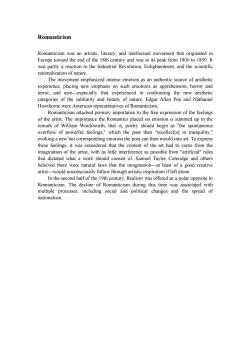上海交通大学:《英语文学导论 An Introduction to English Literature》课程教学资源(阅读资料)Romanticism

Romanticism Romanticism was an artistic,literary,and intellectual movement that originated in Europe toward the end of the 18th century and was at its peak from 1800 to 1850.It was partly a reaction to the Industrial Revolution,Enlightenment,and the scientific rationalization of nature. The movement emphasized intense emotion as an authentic source of aesthetic experience,placing new emphasis on such emotions as apprehension,horror and terror,and awe-especially that experienced in confronting the new aesthetic categories of the sublimity and beauty of nature.Edgar Allan Poe and Nathaniel Hawthorne were American representatives of Romanticism, Romanticism attached primary importance to the free expression of the feelings of the artist.The importance the Romantics placed on emotion is summed up in the remark of William Wordsworth,that is,poetry should begin as "the spontaneous overflow of powerful feelings,"which the poet then "recollect[s]in tranquility," evoking a new but corresponding emotion the poet can then mould into art.To express these feelings,it was considered that the content of the art had to come from the imagination of the artist,with as little interference as possible from "artificial"rules that dictated what a work should consist of.Samuel Taylor Coleridge and others believed there were natural laws that the imagination-at least of a good creative artist-would unconsciously follow through artistic inspiration if left alone. In the second half of the 19th century,Realism was offered as a polar opposite to Romanticism.The decline of Romanticism during this time was associated with multiple processes,including social and political changes and the spread of nationalism
Romanticism Romanticism was an artistic, literary, and intellectual movement that originated in Europe toward the end of the 18th century and was at its peak from 1800 to 1850. It was partly a reaction to the Industrial Revolution, Enlightenment, and the scientific rationalization of nature. The movement emphasized intense emotion as an authentic source of aesthetic experience, placing new emphasis on such emotions as apprehension, horror and terror, and awe—especially that experienced in confronting the new aesthetic categories of the sublimity and beauty of nature. Edgar Allan Poe and Nathaniel Hawthorne were American representatives of Romanticism, Romanticism attached primary importance to the free expression of the feelings of the artist. The importance the Romantics placed on emotion is summed up in the remark of William Wordsworth, that is, poetry should begin as "the spontaneous overflow of powerful feelings," which the poet then "recollect[s] in tranquility," evoking a new but corresponding emotion the poet can then mould into art. To express these feelings, it was considered that the content of the art had to come from the imagination of the artist, with as little interference as possible from "artificial" rules that dictated what a work should consist of. Samuel Taylor Coleridge and others believed there were natural laws that the imagination—at least of a good creative artist—would unconsciously follow through artistic inspiration if left alone. In the second half of the 19th century, Realism was offered as a polar opposite to Romanticism. The decline of Romanticism during this time was associated with multiple processes, including social and political changes and the spread of nationalism
按次数下载不扣除下载券;
注册用户24小时内重复下载只扣除一次;
顺序:VIP每日次数-->可用次数-->下载券;
- 上海交通大学:《英语文学导论 An Introduction to English Literature》课程教学资源(阅读资料)Reading Material of English Poetry.docx
- 上海交通大学:《英语文学导论 An Introduction to English Literature》课程教学资源(阅读资料)Pygmalion.docx
- 上海交通大学:《英语文学导论 An Introduction to English Literature》课程教学资源(阅读资料)Pygmalion(in-class).docx
- 上海交通大学:《英语文学导论 An Introduction to English Literature》课程教学资源(阅读资料)Poems of Langston Hughes.docx
- 上海交通大学:《英语文学导论 An Introduction to English Literature》课程教学资源(阅读资料)Poems by Ezra Pound.docx
- 上海交通大学:《英语文学导论 An Introduction to English Literature》课程教学资源(阅读资料)Mrs Dalloway(excerpts).docx
- 上海交通大学:《英语文学导论 An Introduction to English Literature》课程教学资源(阅读资料)Macbeth.doc
- 上海交通大学:《英语文学导论 An Introduction to English Literature》课程教学资源(阅读资料)Macbeth(in-class).doc
- 上海交通大学:《英语文学导论 An Introduction to English Literature》课程教学资源(阅读资料)How to Write a Critical Essay.docx
- 上海交通大学:《英语文学导论 An Introduction to English Literature》课程教学资源(阅读资料)How to Read a Poem.docx
- 上海交通大学:《英语文学导论 An Introduction to English Literature》课程教学资源(阅读资料)Harlem Renaissance and Langston Hughes.docx
- 上海交通大学:《英语文学导论 An Introduction to English Literature》课程教学资源(阅读资料)Francis Bacon课的阅读材料.docx
- 上海交通大学:《英语文学导论 An Introduction to English Literature》课程教学资源(阅读资料)Francis Bacon一年级课.docx
- 上海交通大学:《英语文学导论 An Introduction to English Literature》课程教学资源(阅读资料)Ezra Pound.docx
- 上海交通大学:《英语文学导论 An Introduction to English Literature》课程教学资源(阅读资料)Criticism on William Shakespeare and Robert Burns.docx
- 上海交通大学:《英语文学导论 An Introduction to English Literature》课程教学资源(阅读资料)a modest proposal text.docx
- 上海交通大学:《英语文学导论 An Introduction to English Literature》课程教学资源(阅读资料)Wuthering Heights.docx
- 上海交通大学:《英语文学导论 An Introduction to English Literature》课程教学资源(阅读资料)Pride and Prejudice.docx
- 上海交通大学:《英语文学导论 An Introduction to English Literature》课程教学资源(PPT讲稿)英语文学导论PPT(戏剧)Shaw.pptx
- 上海交通大学:《英语文学导论 An Introduction to English Literature》课程教学资源(PPT讲稿)英语文学导论PPT(戏剧)Shakespeare.pptx
- 上海交通大学:《英语文学导论 An Introduction to English Literature》课程教学资源(阅读资料)the case of lady sannox text.docx
- 上海交通大学:《英语文学导论 An Introduction to English Literature》课程教学资源(阅读资料)The Death of A Salesman.pdf
- 上海交通大学:《英语文学导论 An Introduction to English Literature》课程教学资源(阅读资料)The Faerie Queene.doc
- 上海交通大学:《英语文学导论 An Introduction to English Literature》课程教学资源(阅读资料)THE FIRST BOOK OF FAIRIE QUEENE.doc
- 上海交通大学:《英语文学导论 An Introduction to English Literature》课程教学资源(阅读资料)the minister's black veil text.docx
- 上海交通大学:《英语文学导论 An Introduction to English Literature》课程教学资源(阅读资料)Thomas Paine一年级课1.docx
- 上海交通大学:《英语文学导论 An Introduction to English Literature》课程教学资源(阅读资料)Thomas Paine课的阅读材料.docx
- 上海交通大学:《英语文学导论 An Introduction to English Literature》课程教学资源(阅读资料)Virginia Woolf and the stream of consciouness technique.docx
- 上海交通大学:《英语文学导论 An Introduction to English Literature》课程教学资源(阅读资料)Walt Whitman's Poems.docx
- 上海交通大学:《英语文学导论 An Introduction to English Literature》课程教学资源(阅读资料)Walt Whitman.docx
- 上海交通大学:《英语文学导论 An Introduction to English Literature》课程教学资源(阅读资料)Washington Irving's The Legend of Sleepy Hollow.docx
- 上海交通大学:《英语文学导论 An Introduction to English Literature》课程教学资源(阅读资料)Washington Irving的阅读材料.docx
- 上海交通大学:《英语文学导论 An Introduction to English Literature》课程教学资源(阅读资料)William Shakespeare.docx
- 上海交通大学:《英语文学导论 An Introduction to English Literature》课程教学资源(阅读资料)William Wordsworth.docx
- 上海交通大学:《英语文学导论 An Introduction to English Literature》课程教学资源(阅读资料)中国诗歌欣赏1.docx
- 上海交通大学:《英语文学导论 An Introduction to English Literature》课程教学资源(阅读资料)阅读Poems of Robert Burns.doc
- 上海交通大学:《英语文学导论 An Introduction to English Literature》课程教学资源(阅读资料)阅读The Canterbury Tales.docx
- 上海交通大学:《英语文学导论 An Introduction to English Literature》课程教学资源(阅读资料)麦克白.doc
- 上海交通大学:《英语文学导论 An Introduction to English Literature》课程教学资源(教学大纲)Reading List of English Poetry.docx
- 上海交通大学:《英语文学导论 An Introduction to English Literature》课程教学资源(教学大纲)Reading Material of English Poetry.docx
